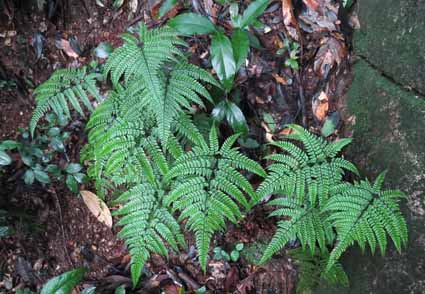Abstract
Arachniodes breviaristata, a new species of Dryopteridaceae from Jiangxi, China, is described and illustrated. The new species is most similar to A. exilis in terms of pinnule shape and serrature form, but can be easily recognized by its lamina shape, degree of shrinkage of the lamina apex and relative length of basiscopically basal pinnules of the lowest pinnae. The new species is suggested to be classified as Critically Endangered (CR) following IUCN Red List Criteria.
References
- Blume, C.L. von (1828) Enumeratio Plantarum Javae et insularum adjacentium: minus cognitarum vel novarum ex herbariis Reinwardtii, Kohlii, Hasseltii et Blumii. Fasc. 2. F. & H. Hartmann, Den Haag, pp. 165–241. https://doi.org/10.5962/bhl.title.44901
- Ching, R.-C. (1962) On the nomenclature of the compound-leaved polysticha. Acta Botanica Sinica 10 (3): 253–263.
- Ching, R.-C. (1964) Notes on some confused species of Arachniodes Bl. Acta Phytotaxonomica Sinica 9 (4): 383–385.
- Forster, G. (1786) Florulae Insularum Australium Prodromus. J.C. Dietrich, Göttingen, 103 pp. https://doi.org/10.5962/bhl.title.10725
- Hance, H.F. (1883) Heptadem filicum novarum sinicarum. Journal of Botany, British and Foreign 21 (9): 267–270.
- He, H., Wu, S.-G., Xiang, J.-Y. & Barrington, D.S. (2013) Arachniodes Blume. In: Wu, Z.-Y., Raven, P.H. & Hong, D.-Y. (Eds.) Flora of China. Vols. 2–3. Science Press, Beijing & Missouri Botanical Garden Press, St. Louis, pp. 542–558.
- Hsieh, Y.-T. (2000) Arachniodes (Dryopteridaceae). In: Wu, C.-Y. (Eds.) Flora Reipublicae Popularis Sinicae. Vol. 5 (1). Science Press, Beijing, pp. 14–95.
- IUCN. (2017) The IUCN Red List of Threatened Species. Version 2017-1. Available from: www.iucnredlist.org (accessed: 6 December 2023).
- Kurata, S. (1965) Notes on Japanese ferns (36) Journal of Geobotany; or the Hokuriku Journal of Botany 13: 98–101.
- Léveillé, H. (1914–1915) Flore du Kouy-Tchéou 456.
- Lu, N.T., Nguyen, L.P., Le, C.T., Nguyen, T.T & Zhang, L. (2021) Arachniodes libingii sp. nov. and A. vietnamensis sp. nov. (Dryopteridaceae), two new ferns from southern China and central Vietnam. Phytotaxa 522 (3): 256–262. https://doi.org/10.11646/phytotaxa.522.3.9
- Lu, N.T., Ebihara, A., He, H., Zhang, L., Zhou, X.-M., Knapp, R., Kamau, P., Lorence, D., Gao, X.-F. & Zhang, L.-B. (2019) A plastid phylogeny of the fern genus Arachniodes (Dryopteridaceae). Molecular Phylogenetics and Evolution 133: 214–235. https://doi.org/10.1016/j.ympev.2018.12.013
- Makino, T. (1899) Plantae Japonenses novae vel minus cognitae. Botanical Magazine, Tokyo 13 (146): 57–58. https://doi.org/10.15281/jplantres1887.13.147_61
- Nakaike, T. (1975) Aspidiaceae. In: Enumeratio Pteridophytarum Japonicarum. Univ. Tokyo Press, Tokyo, pp. 183–194.
- Nakaike, T. (2001) A synoptical study on the fern genus Arachniodes Blume (Dryopteridaceae). Journal of Phytogeography and Taxonomy 49: 7–30. http://doi.org/10.24517/00055346
- Rosenstock, E. (1914) XXXV. Filices extremi orientis novae II. Repertorium Specierum Novarum Regni Vegetabilis 13 (355–358): 129–135. https://doi.org/10.1002/fedr.19140130902
- Tindale, M.D. (1961) Studies in Australian pteridophytes, No. 3. Contributions from the New South Wales National Herbarium 3 (1): 88–92.


